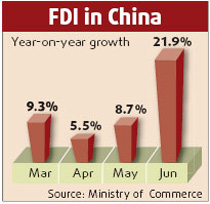Rising labor cost and more buying power has shot up prices of essentials and other goods. Even after the shortage in supply of essentials, especially pork, and other commodities is overcome, the trend of rising prices is expected to continue for some time. The cost of labor in the country's coastal region has been increasing by up to 20 percent a year since 2004, pushing up prices of most consumer products. And why has labor cost gone up? The answer is not difficult: Because there has been a dearth of laborers in China's economic hubs of Yangtze River Delta and Pearl River Delta regions since 2003.
These are the views of Justin Lin, director of Peking University's China Center for Economic Research. Talking to China Daily after the consumer price index (CPI) hit a 10-year high in July - a year-on-year increase of 5.6 percent, Lin said: "We have already entered a cycle of high prices and the trend will last for a relatively long period."
Official analysis, however, blames prices of food products and pork that jumped 15.4 percent year-on-year in July, for the record rise in CPI. The blue-ear pig disease outbreak has forced many breeders to slaughter their sows and piglets this year making pork scarce in the market. In fact, pork price in June soared 74.6 percent year-on-year, playing havoc with the market.
Though Lin is worried about the dramatic rise in pork price, he is pretty sure that the measures taken by the government will bring it down. But what he is also pretty sure of is that overall prices will remain high. Lin should know what he is talking about because he is vice-chairman of two top-notch advisory bodies to the government: Committee for Economic Affairs of the Chinese People's Political Consultative Conference (CPPCC) and the All-China Federation of Industry and Commerce.
But why does he think so? Lin said that's because urban and rural consumers both have more buying power today. In the first six months of the year, the per capita disposable monthly income of urban residents reached 1,175 yuan ($155), a year-on-year increase of 14.2 percent, and that of rural residents, 352 yuan ($47), a 13.3 percent increase.
Moreover, for the first time in a decade the income of both urban and rural residents has exceeded the pace of economic growth, which was 11.5 percent in the first half of the year.
Also, over-production has been dropping, coupled with which the growing demand for goods is shooting up prices, Lin said. Official studies recorded over-production in 12 categories of commodities in 2003. Today it has dropped to just six categories. "We will realize gradually that consumption plays a bigger role in keeping up prices," Lin said.
Lin urged the central bank to use interest leverage to rein in the blistering investment growth. "As a short-term leverage tool, the government should increase the interest rate to check the fast pace of investment growth," rising at 25 percent a year since 2003.
The government, however, will also have to update its industrial policy guidelines and standards for entry into the market to meet its macroeconomic control goal, he said. The government should stipulate a higher ratio of capital owned by investors and banks when a business is set up, Lin said, and suggested "30 percent should be reasonable".
"It's a pity," he said, "that there's no minimum capital requirement for some sectors."
(China Daily August 20, 2007)


